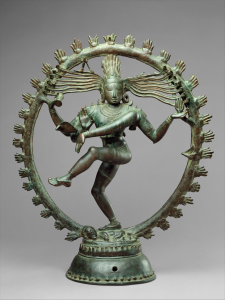Context:
Recently, The G20 Leaders’ Summit at Bharat Mandapam, New Delhi, featured a stunning 27-foot Nataraja sculpture, the world’s tallest representation of Lord Shiva in his dancing form.

Relevance
GS I: Indian Art Forms
Dimensions of the Article:
- Key Highlights of the Nataraja Statue in Bharat Mandapam
- The Lost Wax Method
- History and Religious Symbolism of Lord Shiva’s Dancing Form (Nataraja)
Key Highlights of the Nataraja Statue in Bharat Mandapam:
- Material and Weight: The Nataraja statue at Bharat Mandapam is a remarkable creation made from an ashtadhatu, which is an eight-metal alloy. It boasts a substantial weight of 18 tonnes.
- Renowned Sculptor: The statue is the work of the renowned sculptor Radhakrishnan Sthapaty, hailing from Swami Malai in Tamil Nadu. His expertise and craftsmanship are evident in the statue’s intricate details.
- Inspired Design: The design of this Nataraja statue draws inspiration from three revered Nataraja idols. These idols are located at the Thillai Nataraja Temple in Chidambaram, the Uma Maheswarar Temple in Konerirajapuram, and the Brihadeeswara (Big) Temple in Thanjavur, a UNESCO World Heritage Site. This amalgamation of inspirations adds profound historical and religious symbolism to Lord Shiva’s dancing form.
- Lost Wax Method: The Nataraja sculpture at Bharat Mandapam is created using the lost wax method, which is a traditional and intricate technique for crafting metal sculptures.
The Lost Wax Method:
The lost wax method, also known as investment casting or cire perdue (French for “lost wax”), is a traditional and ancient technique for creating intricate metal sculptures and castings. Here’s an overview of the process:
- Wax Model Creation: Sculptors begin by creating a detailed and finely crafted wax model of the desired sculpture. This wax model is an exact replica of the final metal sculpture, capturing all the intricate details and nuances.
- Mold Encasement: The wax model is then coated with layers of a special mixture, traditionally made of alluvial soil or clay. This outer mold encases the wax model entirely.
- Wax Removal: The mold is heated, causing the wax within to melt and flow out of the mold. This step leaves behind a cavity or negative space that exactly matches the shape of the original wax model. Hence, the term “lost wax” refers to the wax being lost during this process.
- Metal Casting: The mold, now with the hollow space, is ready for casting. Molten metal, often a bronze alloy in the case of sculptures like the Nataraja, is poured into the mold. The metal fills the void left by the melted wax.
- Cooling and Solidification: The poured metal cools and solidifies within the mold, taking the shape of the original wax model. The metal may be further worked and polished once it has cooled.
- Mold Breakage: The outer mold (usually made of clay or soil) is carefully broken away, revealing the metal sculpture inside. This step requires precision to avoid damaging the finished artwork.
- Finishing and Detailing: The final sculpture is then meticulously finished, detailed, and polished by skilled artisans to achieve the desired appearance.
History and Religious Symbolism of Lord Shiva’s Dancing Form (Nataraja):

Ancient Roots of Shiva:
- Shiva, a principal deity in Hinduism, has ancient origins dating back to the Vedic period.
- In early Vedic scriptures, Shiva’s precursor is Rudra, a deity associated with natural elements such as storms, thunder, and the wild forces of nature.
- Rudra was initially portrayed as a fierce and formidable deity embodying the destructive aspects of the natural world.
Evolution of Shiva as Nataraja:
- The concept of Shiva as a dancer, known as Nataraja, began to take shape around the 5th century AD.
- Early depictions of Shiva’s dance laid the foundation for the multifaceted symbolism associated with the Nataraja form.
Chola Dynasty Influence:
- During the reign of the Chola dynasty (9th-11th centuries AD), Shiva’s Nataraja form underwent significant development.
- The Cholas, known for their patronage of art and culture, played a pivotal role in shaping the cultural significance of Nataraja.
- They were devout Shaivites, emphasizing the worship of Lord Shiva, and constructed grand Shiva temples throughout their territories, with a particular focus on Shaiva figures in their sculptures.
Evolution of Nataraja Iconography:
- Under the Cholas, Nataraja’s symbolism grew more complex. Lord Shiva, a complex deity embodying both destructive and ascetic qualities, became celebrated for his invention of 108 diverse dances, symbolizing both creation and destruction.
- His dance was viewed as a cosmic dance on the world stage.
Iconic Elements of Nataraja:
- In iconic representations, Nataraja is depicted within a flaming aureole or halo, symbolizing the circle of the world.
- His long, flowing dreadlocks signify the energy and dynamism of his dance.
- Nataraja is typically shown with four arms, each holding symbolic objects conveying deeper meanings.
Symbolism in Nataraja’s Attributes:
- Nataraja’s attributes hold symbolic significance. His damru (hand drum) draws all creatures into his rhythmic motion, while Agni (fire) in his upper left arm symbolizes his power to destroy the universe.
- Beneath his foot lies a crushed dwarf-like figure, representing illusion and worldly distractions.
- The fusion of male and female, represented by one earring in each ear, is referred to as Ardhanarishwar.
- A snake coiled around his arm symbolizes the dormant kundalini power in the human spine.
Nataraja as Protector and Reassurer:
- Despite formidable symbolism, Nataraja serves as a protector. His “abhayamudra” (fear-allaying gesture) and inviting posture reassure devotees, offering protection from fear and doubt.
Nataraja’s Smile:
- A distinctive feature of Nataraja’s iconography is his almost ever-present broad smile, representing both “death and life, both joy and pain.”
- This smile embodies the dualities of existence.
-Source: Indian Express





